 The pad in January 2024 during the launch of Axiom Mission 3 with the SpaceX Starship launch tower in the background The pad in January 2024 during the launch of Axiom Mission 3 with the SpaceX Starship launch tower in the background | |||||||||||||
| Launch site | Kennedy Space Center | ||||||||||||
|---|---|---|---|---|---|---|---|---|---|---|---|---|---|
| Location | Merritt Island, Florida | ||||||||||||
| Coordinates | 28°36′30″N 80°36′16″W / 28.60833°N 80.60444°W / 28.60833; -80.60444 | ||||||||||||
| Time zone | UTC−05:00 (EST) | ||||||||||||
| • Summer (DST) | UTC−04:00 (EDT) | ||||||||||||
| Operator | |||||||||||||
| Orbital inclination range | 28.5–55, 66–145° | ||||||||||||
| |||||||||||||
| Launch Complex 39--Pad A | |||||||||||||
| U.S. National Register of Historic Places | |||||||||||||
  | |||||||||||||
| Area | 160 acres (65 ha) | ||||||||||||
| Built | 1964–1968 | ||||||||||||
| MPS | John F. Kennedy Space Center MPS | ||||||||||||
| NRHP reference No. | 99001638 | ||||||||||||
| Added to NRHP | January 21, 2000 | ||||||||||||
Launch Complex 39A (LC-39A) is the first of Launch Complex 39's three launch pads, located at NASA's Kennedy Space Center in Merritt Island, Florida. The pad, along with Launch Complex 39B, was first constructed in the 1960s to accommodate the Saturn V launch vehicle, and has been used to support NASA crewed space flight missions, including the historic Apollo 11 moon landing and the Space Shuttle. The site is currently leased by SpaceX and supports launches of the Falcon 9 and Falcon Heavy rockets.
History
Apollo program
In 1961, U.S. President Kennedy proposed to the U.S. Congress the goal of landing a man on the Moon by the end of the decade. Congressional approval led to the launch of the Apollo program, which required a massive expansion of NASA operations, including an expansion of launch operations from the Cape to adjacent Merritt Island to the north and west.
First named Launch Complex 39C, Launch Complex 39A was designed to handle launches of the Saturn V rocket, the largest and most powerful launch vehicle, which would propel the Apollo spacecraft to the Moon. The first launch from Launch Complex 39A occurred in 1967 with the first Saturn V launch, which carried the uncrewed Apollo 4 spacecraft. The second uncrewed launch, Apollo 6, also used Pad 39A. With the exception of Apollo 10, which used Pad 39B (due to the "all-up" testing resulting in a 2-month turnaround period), all crewed Apollo-Saturn V launches, commencing with Apollo 8, used Pad 39A.
Skylab program
Launch Complex 39A was used for the uncrewed launch of the Skylab space station on May 14, 1973. This used a modified Saturn V originally built for the cancelled Apollo 18 mission. The subsequent Skylab crewed missions launched from Launch Complex 39B using Saturn IB launch vehicles.
Space Shuttle
With the advent of the Space Shuttle program in the early 1980s, the original structure of the launch pads were remodeled for the needs of the Space Shuttle. The first usage of Pad 39A for the Space Shuttle came in 1979, when Enterprise was used to check the facilities prior to the first operational launch. Since then, Pad 39A hosted all Space Shuttle launches until January 1986, when Space Shuttle Challenger would become the first to launch from pad 39B during the ill-fated STS-51-L mission.
During the launch of Discovery on STS-124 on May 31, 2008, the pad at LC-39A suffered extensive damage, in particular to the concrete trench used to deflect the SRBs' flames. The subsequent investigation found that the damage was the result of carbonation of epoxy and corrosion of steel anchors that held the refractory bricks in the trench in place. The damage had been exacerbated by the fact that hydrochloric acid is an exhaust by-product of the solid rocket boosters.
Just as for the first 24 shuttle flights, LC-39A supported the final shuttle flights, starting with STS-117 in June 2007 and ending with the retirement of the Shuttle fleet in July 2011. In total, Pad 39A hosted 94 launches from 1967 to 2011, including 12 Saturn V rockets and 82 space shuttles. Prior to the SpaceX lease agreement, the pad remained as it was when Atlantis launched on the final shuttle mission on July 8, 2011, complete with a mobile launcher platform. The pad was originally going to be modified for the Ares V rocket for the Constellation program in the mid 2010s, looking identical to LC-39B with the three lightning towers. The Ares I was planned to launch on the adjacent 39B but in 2010, the Constellation program was cancelled.
SpaceX
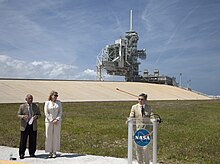
Talks for use of the pad were underway between NASA and Space Florida—the State of Florida's economic development agency—as early as 2011, but no deal materialized by 2012, and NASA then pursued other options for removing the pad from the federal government inventory.
By early 2013, NASA publicly announced that it would allow commercial launch providers to lease LC-39A, and followed that, in May 2013, with a formal solicitation for proposals for commercial use of the pad. There were two competing bids for the commercial use of the launch complex. SpaceX submitted a bid for exclusive use of the launch complex, while Jeff Bezos' Blue Origin submitted a bid for shared non-exclusive use of the complex, so that the launchpad would handle multiple vehicles, and costs could be shared over the long-term. One potential shared user in the Blue Origin plan was United Launch Alliance. Prior to the end of the bid period, and prior to any public announcement by NASA of the results of the process, Blue Origin filed a protest with the U.S. General Accounting Office (GAO) "over what it says is a plan by NASA to award an exclusive commercial lease to SpaceX for use of mothballed space shuttle launch pad 39A". NASA had planned to complete the bid award and have the pad transferred by October 1, 2013, but the protest "will delay any decision until the GAO reaches a decision, expected by mid-December". On December 12, 2013, the GAO denied the protest and sided with NASA, which argued that the solicitation contained no preference on the use of the facility as multi-use or single-use. "The document merely asks bidders to explain their reasons for selecting one approach instead of the other and how they would manage the facility".
On December 13, 2013, NASA announced that it had selected SpaceX as the new commercial tenant. On April 14, 2014, SpaceX signed a lease agreement that gave it a 20-year exclusive lease on LC-39A. SpaceX planned to launch their launch vehicles from the pad and build a new hangar nearby. Elon Musk, CEO of SpaceX, stated that he wanted to shift most of SpaceX's NASA launches to LC-39A, including commercial cargo and crew missions to the International Space Station.
Modifications
In 2015, SpaceX built the Horizontal Integration Facility (HIF) just outside the perimeter of the existing launch pad in order to house both the Falcon 9 and the Falcon Heavy rockets, and their associated hardware and payloads, during preparation for flight. Both types of launch vehicles are transported from the HIF to the launch pad aboard a Transporter Erector (TE) which rides on rails up the former crawlerway path. Also in 2015, the launch mount for the Falcon Heavy was constructed on Pad 39A over the existing infrastructure. The work on both the HIF building and the pad was substantially complete by late 2015. A rollout test of the new Transporter Erector was conducted in November 2015.
In February 2016, SpaceX indicated that they had "completed and activated Launch Complex 39A", but still had more work yet to do to support crewed flights. SpaceX originally planned to be ready to accomplish the first launch at pad 39A—of a Falcon Heavy—as early as 2015, as they had architects and engineers working on the new design and modifications since 2013. By late 2014, a preliminary date for a wet dress rehearsal of the Falcon Heavy was set for no earlier than July 1, 2015. Due to a failure in a June 2015 Falcon 9 launch, SpaceX delayed launching the Falcon Heavy in order to focus on the Falcon 9's failure investigation and its return to flight. In early 2016, considering the busy Falcon 9 launch manifest, it became unclear if the Falcon Heavy would be the first vehicle to launch from Pad 39A, or if one or more Falcon 9 missions would precede a Falcon Heavy launch. In the following months, the Falcon Heavy launch was delayed multiple times and eventually pushed back to February 2018.
SpaceX used the former Fixed Service Structure (FSS) of the Pad 39A launch towers and initially intended to extend it above its former 350-foot (110 m) height. It did not need the Rotating Service Structure (RSS) and removed it beginning in February 2016.
NASA removed the Orbiter Servicing Arm—with intent to use the space later to build a museum—and the white room by which astronauts entered the Space Shuttle. SpaceX indicated in late 2014 that additional levels to the FSS would not be added in the near term. SpaceX planned to eventually add at least two additional levels to the FSS, to provide crew access for the Dragon 2 launches.
In August 2018, SpaceX's Crew Access Arm (CAA) was installed on a new level, which was built at the necessary height to enter the Crew Dragon spacecraft atop a Falcon 9 rocket. It very closely resembles jetways that are frequently found at airports. In September 2018, the refurbished Space Shuttle Emergency Egress System was raised to this new level.
SpaceX added a crew gantry access arm and white room to allow for crew and cargo ingress to the vehicle. The existing Space Shuttle evacuation slide-wire basket system was re-purposed to provide a safe emergency egress for the Dragon crew in the event of an emergency on the pad that does not necessitate using the Crew Dragon's launch abort system".
In 2019, SpaceX began substantial modification to LC 39A in order to begin work on phase 1 of the construction to prepare the facility to launch prototypes of the large 9 m (30 ft)-diameter methalox reusable rocket—Starship—from a launch stand, which would fly from 39A on suborbital test flight trajectories with six or fewer Raptor engines. A second phase of the construction was planned for 2020 to build a much more capable launch mount capable of launching the entire Starship launch vehicle, powered by 33 Raptor engines and producing a total of 72 MN (16,000,000 lbf) liftoff thrust when departing 39A.
In August 2019, SpaceX submitted an Environmental Assessment for the Starship launch system at Kennedy Space Center. This document included plans for the construction of additional structures at LC-39A to support Starship launches, including a dedicated pad, liquid methane tanks, and a Landing Zone. These are separate from the existing structures that support Falcon 9 and Falcon Heavy launches.
In December 2021, SpaceX started construction of a Starship orbital launch pad on the site.
On June 16, 2022, the first tower segment for the Starship orbital pad arrived at LC-39A. Stacking began on June 21, and the Starship launch mount was also under construction. In 2024, an additional Environmental Impact Statement was underway to support an annual launch cadence of 40+ Starship launches.
Launch history
The first SpaceX launch from pad 39A was SpaceX CRS-10 on February 19, 2017, using a Falcon 9 launch vehicle; it was the company's 10th cargo resupply mission to the International Space Station, and the first uncrewed launch from 39A since Skylab.
While Cape Canaveral Space Launch Complex 40 (SLC-40) was undergoing reconstruction after the loss of the AMOS-6 satellite on September 1, 2016, all SpaceX's east coast launches were from Pad 39A until SLC-40 became operational again in December 2017. These included the May 1, 2017, launch of NROL-76, the first SpaceX mission for the National Reconnaissance Office, with a classified payload.
On February 6, 2018, Pad 39A hosted the successful liftoff of the Falcon Heavy on its maiden launch, carrying Elon Musk's Tesla Roadster car to space; and the first flight of the human-rated spacecraft Dragon 2; (Demo-1) took place there on March 2, 2019.
The second Falcon Heavy flight, carrying the Arabsat-6A communications satellite for Arabsat of Saudi Arabia, successfully launched on April 11, 2019. The satellite is to provide Ku-band and Ka-band communication services for the Middle East and northern Africa, as well as for South Africa. The launch was notable as it marked the first time that SpaceX was able to successfully soft-land all three of the reusable booster stages, which were to be refurbished for future launches.
The Crew Dragon Demo-2 test flight launched with astronauts Bob Behnken and Doug Hurley from Launch Complex 39A on 30 May 2020, and docked to pressurised mating adapter PMA-2 on the Harmony module of the ISS on 31 May 2020. The first operational Commercial Crew mission Crew-1 was launched on November 15, 2020.
SpaceX launched the IM-1 robotic lander for NASA's Commercial Lunar Payload Services program on 15 February 2024, returning the pad to Lunar missions since the end of the Apollo program. The Starlink Group 6-56 mission launched on 8 May 2024, and was the Falcon 9's 83rd launch from LC-39A. That milestone made the rocket family the pad leader for launches from that launch complex, surpassing the Space Shuttle's 82 launches.
Launch statistics
6 12 18 24 30 1965 1970 1975 1980 1985 1990 1995 2000 2005 2010 2015 2020 2025Current status

The private American aerospace manufacturer and space transportation services company SpaceX has been the lease holder as of April 14, 2014. The terms of the agreement gave SpaceX a 20-year exclusive lease to LC-39A. SpaceX has launched their launch vehicles from the pad since the launch of the SpaceX CRS-10 Dragon resupply mission in 2017, and crewed missions since the launch of the Crew Dragon Demo-2 mission in 2020. Currently Pad 39A is used to host launches of astronauts on the crewed-version of the Dragon space capsule in a public–private partnership with NASA.
SpaceX assembles its launch vehicles horizontally in a hangar near the pad and transports them horizontally to the pad before erecting the vehicle to vertical for the launch. For military missions from Pad 39A, payloads are vertically integrated, as that is required per a launch contract with the United States Air Force.
Lists of launches
Apollo program
For Apollo program launches from LC-39A see the list of uncrewed and crewed Apollo missions.
Skylab program
For the uncrewed launch of the Skylab space station from LC-39A, see Skylab § Completion and launch.
Space Shuttle program
For Space Shuttle program launches from LC-39A see List of space shuttle launches.
SpaceX
For SpaceX launches from LC-39A see List of Falcon 9 and Falcon Heavy launches.
Gallery
-
 Apollo 11 launch at LC-39A (1969)
Apollo 11 launch at LC-39A (1969)
-
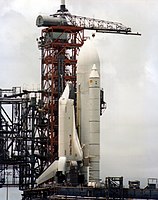 Space Shuttle Enterprise at LC-39A during the fit check tests (1979)
Space Shuttle Enterprise at LC-39A during the fit check tests (1979)
-
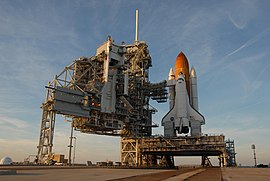 Space Shuttle Atlantis at LC-39A (2007)
Space Shuttle Atlantis at LC-39A (2007)
- Deluge system test at pad 39A (2017)
-
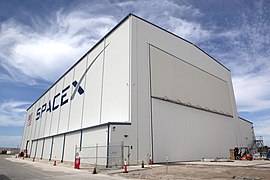 SpaceX Horizontal Integration Facility (HIF)
SpaceX Horizontal Integration Facility (HIF)
-
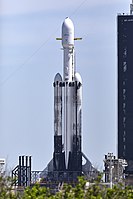 Falcon Heavy at LC-39A (2019)
Falcon Heavy at LC-39A (2019)
-
 Construction of the future launch tower for the dedicated SpaceX Starship launch pad at LC-39A (2022)
Construction of the future launch tower for the dedicated SpaceX Starship launch pad at LC-39A (2022)
See also
References
- "Falcon User's Guide" (PDF). SpaceX. September 2021. p. 11.
- "National Register Information System". National Register of Historic Places. National Park Service. July 9, 2010.
 This article incorporates text from this source, which is in the public domain.
This article incorporates text from this source, which is in the public domain.
- D'Orazio, Dante (September 6, 2015). "After delays, SpaceX's massive Falcon Heavy rocket set to launch in spring 2016". The Verge. Vox Media. Archived from the original on November 25, 2019. Retrieved May 20, 2020.
- "Spacex seeks to accelerate falcon 9 production and launch rates this year". SpaceNews. February 4, 2016. Archived from the original on February 9, 2016. Retrieved May 20, 2020.
- "The History of Cape Canaveral, Chapter 3: NASA Arrives (1959–Present)". Spaceline.org. Archived from the original on September 17, 2009. Retrieved July 6, 2009.
- Launch Complex 39.
- "NASA Eyes Launch Pad Damage for Next Shuttle Flight". Space.com. June 2, 2008. Archived from the original on August 15, 2009. Retrieved May 20, 2020.
- Lilley, Steve K. (August 2010). "Hit the Bricks" (PDF). System Failure Case Studies. 4 (8). NASA: 1–4. Archived from the original (PDF) on September 28, 2011. Retrieved July 20, 2011.
 This article incorporates text from this source, which is in the public domain.
This article incorporates text from this source, which is in the public domain.
- "The Milestone Space Missions Launched from NASA's Historic Pad 39A". Space.com. February 17, 2017. Retrieved December 23, 2023.
- "NASA – Kennedy Prepares to Host Constellation". Archived from the original on May 21, 2023. Retrieved May 21, 2023.
- ^ Bergin, Chris (November 18, 2014). "Pad 39A – SpaceX laying the groundwork for Falcon Heavy debut". NASA Spaceflight. Archived from the original on November 19, 2014. Retrieved November 17, 2014.
- "NASA not abandoning LC-39A" January 17, 2013 Archived January 18, 2013, at the Wayback Machine, accessed February 7, 2013.
- NASA requests proposals for commercial use of Pad 39A Archived July 1, 2020, at the Wayback Machine, NewSpace Watch, May 20, 2013, accessed May 21, 2013.
- ^ "Selection Statement for Lease of Launch Complex 39A" (PDF). NASA. December 12, 2013. Archived from the original (PDF) on May 11, 2015. Retrieved December 23, 2013.
 This article incorporates text from this source, which is in the public domain.
This article incorporates text from this source, which is in the public domain.
- Matthews, Mark K. (August 18, 2013). "Musk, Bezos fight to win lease of iconic NASA launchpad". Orlando Sentinel. Archived from the original on August 27, 2013. Retrieved August 21, 2013.
- ^ Messier, Doug (September 10, 2013). "Blue Origin Files Protest Over Lease on Pad 39A". Parabolic Arc. Archived from the original on September 25, 2013. Retrieved September 11, 2013.
- Messier, Doug (December 12, 2013). "Blue Origin Loses GAO Appeal Over Pad 39A Bid Process". Parabolic Arc. Archived from the original on December 16, 2013. Retrieved December 13, 2013.
- ^ Clark, Stephen (December 13, 2013). "SpaceX to begin negotiations for shuttle launch pad". SpaceflightNow. Archived from the original on March 14, 2017. Retrieved December 13, 2013.
- ^ Dean, James (April 14, 2014). "SpaceX takes over KSC pad 39A". Florida Today. Archived from the original on February 20, 2017. Retrieved April 15, 2014.
- ^ Gwynne Shotwell (March 21, 2014). Broadcast 2212: Special Edition, interview with Gwynne Shotwell (audio file). The Space Show. Event occurs at 20:00–21:10. 2212. Archived from the original (mp3) on March 22, 2014. Retrieved March 22, 2014.
- Clark, Stephen (December 12, 2013). "GAO decision opens door for commercial lease of pad 39A". Spaceflight Now. Archived from the original on October 26, 2016. Retrieved December 23, 2013.
Musk said he wants to launch SpaceX's commercial cargo and crew missions to the International Space Station from launch pad 39A
- ^ Clark, Stephen (February 25, 2015). "Falcon Heavy rocket hangar rises at launch pad 39A". Spaceflight Now. Archived from the original on August 7, 2020. Retrieved February 28, 2015.
- ^ "NASA signs over historic Launch Pad 39A to SpaceX". collectSpace. April 14, 2014. Archived from the original on August 24, 2014. Retrieved April 15, 2014.
- Bergin, Chris (February 18, 2015). "Falcon Heavy into production as Pad 39A HIF rises out of the ground". NASASpaceFlight. Archived from the original on May 20, 2020. Retrieved February 19, 2015.
- Gebhardt, Chris (October 8, 2015). "Canaveral and KSC pads: New designs for space access". NASASpaceFlight.com. Archived from the original on October 9, 2015. Retrieved October 11, 2015.
- Bergin, Chris (November 9, 2015). "SpaceX conducts test rollout for 39A Transporter/Erector". NASASpaceFlight.com. Archived from the original on December 19, 2019. Retrieved November 11, 2015.
- ^ Foust, Jeff (February 4, 2014). "SpaceX seeks to accelerate Falcon 9 production and launch rates this year". SpaceNews. Archived from the original on February 9, 2016. Retrieved February 6, 2016.
- Dean, James (April 14, 2014). "With nod to history, SpaceX gets launch pad 39A OK". Florida Today. Archived from the original on July 30, 2014. Retrieved April 15, 2014.
- ^ Clark, Stephen (April 15, 2014). "SpaceX's mega-rocket to debut next year at pad 39A". SpaceflightNow. Archived from the original on March 8, 2020. Retrieved April 16, 2014.
- Clark, Stephen (July 21, 2015). "First flight of Falcon Heavy delayed again". spaceflightnow.com. Archived from the original on August 13, 2020. Retrieved October 6, 2015.
- "SpaceX Performs Falcon Heavy Rocket Static Fire Test After Delays | Stock News & Stock Market Analysis - IBD". Investor's Business Daily. January 24, 2018. Archived from the original on August 3, 2020. Retrieved February 6, 2018.
- "SES-9". SES. October 21, 2014. Archived from the original on October 21, 2014. Retrieved February 23, 2016.
- ^ Bergin, Chris (July 28, 2014). "SpaceX Roadmap building on its rocket business revolution". NASAspaceflight. Archived from the original on July 30, 2014. Retrieved July 28, 2014.
- Clark, Stephen (August 20, 2018). "SpaceX's astronaut walkway installed on Florida launch pad". Spaceflight Now. Archived from the original on August 23, 2018. Retrieved August 22, 2018.
- Reisman, Garrett (February 27, 2015). "Statement of Garrett Reisman before the Subcommittee on Space Committee on Science, Space, and Technology U.S. House Of Representatives" (PDF). US House of Representatives publication of a SpaceX document provided to the committee. Archived (PDF) from the original on September 23, 2018. Retrieved February 28, 2015.
 This article incorporates text from this source, which is in the public domain.
This article incorporates text from this source, which is in the public domain.
- "Construction of Starship 39A launch and landing facility picking up the pace". October 7, 2019. Archived from the original on June 20, 2020. Retrieved May 20, 2020.
- Groh, Jamie (September 28, 2019). "SpaceX debuts Starship's new Super Heavy booster design". Teslarati. Archived from the original on September 29, 2019. Retrieved October 8, 2019.
- "Draft Environmental Assessment for the SpaceX Starship and Super Heavy Launch Vehicle at Kennedy Space Center (KSC)" (PDF). NASA Public NEPA Documents. SpaceX. Archived (PDF) from the original on August 2, 2019. Retrieved September 20, 2019.
 This article incorporates text from this source, which is in the public domain.
This article incorporates text from this source, which is in the public domain.
- Ralph, Eric (September 18, 2019). "SpaceX prepares to break ground on Starship launch facilities at Pad 39A". TESLARATI. Archived from the original on June 22, 2020. Retrieved September 20, 2019.
- @elonmusk (December 3, 2021). "Construction of Starship orbital launch pad at the Cape has begun" (Tweet) – via Twitter.
- @NASASpaceflight (June 16, 2022). "Here comes the first section for the Starship Launch Tower at KSC 39A!" (Tweet) – via Twitter.
- Ralph, Eric (June 22, 2022). "SpaceX begins stacking Florida Starship launch tower". TESLARATI. Archived from the original on June 22, 2022. Retrieved June 23, 2022.
- "Office of Commercial Space Transportation; Notice of Intent to Prepare an Environmental Impact Statement (EIS), Open a Public Scoping Period, and Hold Public Scoping Meetings" (PDF). May 10, 2024. 4910-13.
- spacexcmsadmin (January 29, 2016). "CRS-10 MISSION". SpaceX. Archived from the original on November 26, 2013. Retrieved February 18, 2017.
- Bergin, Chris (March 9, 2017). "SpaceX Static Fires Falcon 9 for EchoStar 23 launch as SLC-40 targets return". NASASpaceFlight.com. Archived from the original on March 9, 2017. Retrieved March 18, 2017.
- Wattles, Jackie. "SpaceX launches Falcon Heavy, the world's most powerful rocket". CNNMoney. Archived from the original on June 21, 2020. Retrieved February 6, 2018.
- "Launch Schedule – Spaceflight Now". Spaceflightnow.com. Archived from the original on December 24, 2016. Retrieved February 20, 2019.
- "Upcoming Spaceflight Events". nextspaceflight.com. Archived from the original on April 11, 2019. Retrieved May 1, 2020.
- Potter, Sean (April 20, 2020). "NASA to Host Preview Briefings for First Crew Launch with SpaceX". NASA. Archived from the original on April 21, 2020. Retrieved April 30, 2020.
 This article incorporates text from this source, which is in the public domain.
This article incorporates text from this source, which is in the public domain.
- "NASA Astronauts Launch from America in Historic Test Flight of SpaceX Crew Dragon". May 30, 2020. Archived from the original on August 20, 2020. Retrieved May 30, 2020.
 This article incorporates text from this source, which is in the public domain.
This article incorporates text from this source, which is in the public domain.
- "SpaceX launches first operational Crew Dragon mission to ISS". November 16, 2020. Archived from the original on January 16, 2023. Retrieved April 8, 2021.
- Fox, Karen; Fisher, Alise; Ramji, Nilufar; Jaramillo, Antonia, eds. (February 15, 2024). "NASA Artemis Science, First Intuitive Machines Flight Head to Moon" (Press release). Archived from the original on May 11, 2024. Retrieved February 20, 2024.
- Robinson-Smith, Will (May 8, 2024). "SpaceX poised to break Space Shuttle pad record with Falcon 9 Starlink mission". Spaceflight Now. Archived from the original on May 8, 2024. Retrieved May 8, 2024.
- "Historic launch pad back in service with thundering blastoff by SpaceX – Spaceflight Now". Retrieved December 10, 2023.
- Hull, Dana; Johnsson, Julie (May 31, 2020) . "SpaceX Astronauts Reach Space Station After Milestone Voyage". Bloomberg News. Archived from the original on September 10, 2024. Retrieved December 10, 2023.
External links
- Launch Complex 39-A Archived April 3, 2019, at the Wayback Machine
- NASA-produced video tour of Shuttle on Pad 39A 1 month before launch
- photos of work areas and catacombs beneath Pad 39A
- Cape Canaveral LC39A from Encyclopedia Astronautica
28°36′30.2″N 80°36′15.6″W / 28.608389°N 80.604333°W / 28.608389; -80.604333
| Kennedy Space Center | ||||||||
|---|---|---|---|---|---|---|---|---|
| Facilities |
|  | ||||||
| Launch sites | ||||||||
| Cape Canaveral and Merritt Island launch and landing sites | |||||||
|---|---|---|---|---|---|---|---|
| Launch sites |
| ||||||
| Landing sites | |||||||
| Related | |||||||
| |||||||
| NASA programs | |||||||||||||||||||||||||||||||||||||||||||||||||||||||||||||||||||||||||||||||||||||||||||||||||||||||||||||||||||||||||||||||||||||
|---|---|---|---|---|---|---|---|---|---|---|---|---|---|---|---|---|---|---|---|---|---|---|---|---|---|---|---|---|---|---|---|---|---|---|---|---|---|---|---|---|---|---|---|---|---|---|---|---|---|---|---|---|---|---|---|---|---|---|---|---|---|---|---|---|---|---|---|---|---|---|---|---|---|---|---|---|---|---|---|---|---|---|---|---|---|---|---|---|---|---|---|---|---|---|---|---|---|---|---|---|---|---|---|---|---|---|---|---|---|---|---|---|---|---|---|---|---|---|---|---|---|---|---|---|---|---|---|---|---|---|---|---|---|
| |||||||||||||||||||||||||||||||||||||||||||||||||||||||||||||||||||||||||||||||||||||||||||||||||||||||||||||||||||||||||||||||||||||
| NASA | |||||||
|---|---|---|---|---|---|---|---|
| Policy and history |
| ||||||
| Human spaceflight programs |
| ||||||
| Robotic programs |
| ||||||
| Individual featured missions (human and robotic) |
| ||||||
| Communications and navigation | |||||||
| NASA lists | |||||||
| NASA images and artwork |
| ||||||
| Related |
| ||||||
| SpaceX | ||||||||||
|---|---|---|---|---|---|---|---|---|---|---|
| History | ||||||||||
| Launch vehicles |
| |||||||||
| Spacecraft |
| |||||||||
| Test vehicles |
| |||||||||
| Rocket engines | ||||||||||
| Lists of missions | ||||||||||
| Launch facilities |
| |||||||||
| Landing sites |
| |||||||||
| Other facilities |
| |||||||||
| Support |
| |||||||||
| Contracts | ||||||||||
| R&D programs | ||||||||||
| Key people |
| |||||||||
| Related | ||||||||||
| * denotes unflown vehicles or engines, and future missions or sites. † denotes failed missions, destroyed vehicles, and abandoned sites. | ||||||||||
- Kennedy Space Center launch sites
- 1964 establishments in Florida
- SpaceX facilities
- National Register of Historic Places in Brevard County, Florida
- Apollo program
- Space Shuttle program
- Historic districts on the National Register of Historic Places in Florida
- Historic American Engineering Record in Florida
- Buildings and structures in Merritt Island, Florida
- Constellation program


